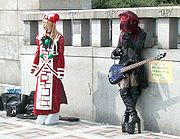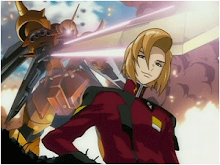Venues

"Jingūbashi" passes over Yamanote Line south of Harajuku Station, Tokyo, at the Meiji Shrine gate. It is a famous gathering place for cosplayers.
Cosplayers typically come from the ranks of otaku--that is, fans of Japanese comic books, known as manga. They gather at public events such as comic-book and video game trade shows, as well as at dedicated cosplay parties at nightclubs or amusement parks. In Japan teenagers gather with like-minded friends in places like Tokyo's Harajuku district to engage in cosplay. Since 1998 Tokyo's Akihabara district has contained a large number of cosplay cafés, catering to devoted anime and cosplay fans. The waitresses at such cafés dress as game or anime characters; maid costumes are particularly popular. In areas outside of Japan, cosplay is primarily done at manga and anime conventions. The single largest event featuring cosplay is the semiannual doujinshi market, Comiket. This event, held in Japan during summer and winter, attracts hundreds of thousands of manga fans. Thousands of cosplayers congregate on the roof of the exhibition center, often in unbearably hot or cold conditions. The largest event for cosplayers outside Asia is the annual Comics Con held in California, USA. Cosplayers in Japan refer to themselves as reiyâ (レイヤー?); pronounced "player". Those who photograph players are called cameko, short for "Camera Kozo" or "Camera Boy". Originally the cameko give prints of their photos to players as gifts. Increased interest in cosplay events both on the part of photographers and cosplayers willing to model for them have led to formalisation of procedures at events such as Comiket. Photography takes place within a designated area removed from the exhibit hall.Cosplay at fan events likely originated in Japan in 1978. Cosplay nevertheless gets a mixed reception in Japan even today. Events in districts such as Akihabara draw many cosplayers, yet there is no shortage of people in Japan who regard cosplay as a frivolous endeavor.
Cosplay in Western culture
The popularity of cosplay in Japan encourages the misconception that cosplay is specifically Japanese or Asian hobby. The term "cosplay", though Japanese in origin described a phenomenon which was witnessed in the United States. For almost fifty years, costuming has had a widespread following and continues to experience growing popularity in North America and Europe, and has more recently spread throughout South America and Australia.
Western cosplay's origins are based primarily on science fiction and historical fantasy as opposed to animation. Western cosplayers tend to recreate characters from live-action series such as Star Trek, Star Wars, Doctor Who, The Lord of the Rings, and Harry Potter than it is for Japanese cosplayers. Western costumers also include subcultures of hobbyists who participate in Renaissance faires, and historical re-enactments such as Civil War battles. The increasing popularity of Japanese animation outside of Asia during the late 1990s led to an increase in American and other Western cosplayers who portray Japanese characters. Anime conventions have become more numerous in the West in the last decade. They now compete with science fiction, comic, and historical conferences in attendance. At these gatherings, cosplayers, like their Japanese counterparts, meet to show off their work, take photos, and compete in costume contests. Differences in taste still exist across cultures. Some costumes that are worn without hesitation by Japanese cosplayers tend to be avoided by Western cosplayers, such as outfits that invoke Nazi-era uniforms.

No comments:
Post a Comment